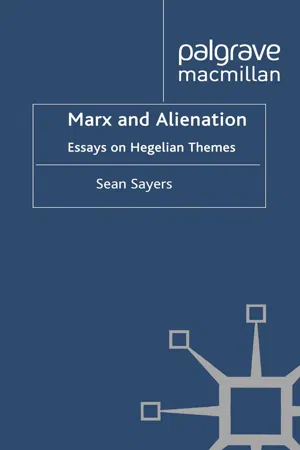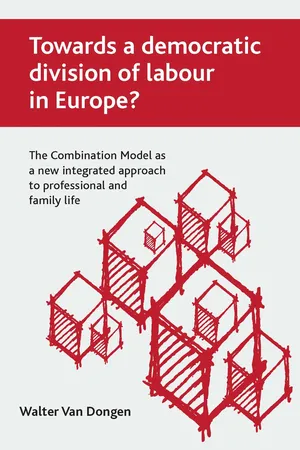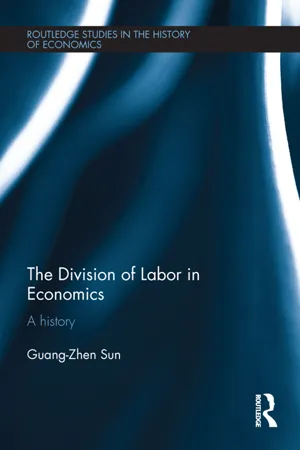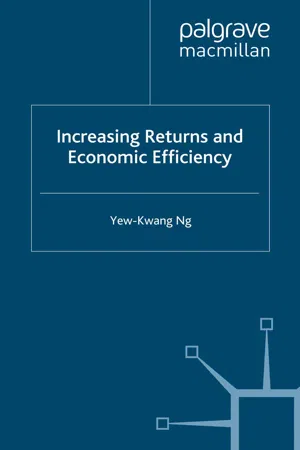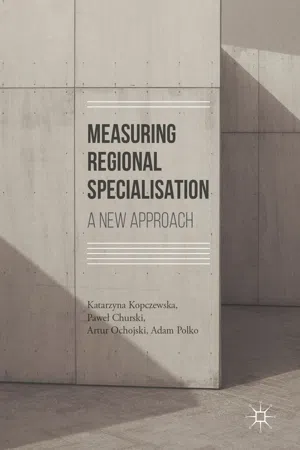Economics
Specialisation and Division of Labour
Specialisation and division of labour refer to the process of individuals or businesses focusing on specific tasks or activities within the production process. This allows for increased efficiency and productivity as each participant can develop expertise in their area of specialisation, leading to overall economic growth and improved resource allocation.
Written by Perlego with AI-assistance
Related key terms
1 of 5
8 Key excerpts on "Specialisation and Division of Labour"
- eBook - PDF
Marx and Alienation
Essays on Hegelian Themes
- Sean Sayers(Author)
- 2011(Publication Date)
- Palgrave Macmillan(Publisher)
14 Few modern thinkers accept this view. Modern advocates of the division of labour tend to argue for it on the prag- matic grounds of economic efficiency. Adam Smith, for example, makes the case for the division of labour in this way. The Division of Labour and Its Overcoming 141 14 In Plato’s (1987, book III) scheme, some are born to rule, some to be soldiers, others to do manual work. See also Aristotle (1981, book I). Cf. the Confucian saying, ‘some are born to rule, others to be ruled’, frequently cited and attacked during the Cultural Revolution in China. Marx questions both of these approaches. The social organisation of labour is not naturally determined, but nor is it simply a matter for pragmatic choice. The division of labour is a fundamental aspect of the system of relations of production and class divisions. At the present stage of economic development, such economic and social relations take on an alien and independent form, they cannot be altered merely at will. Their form corresponds to the level of development of the pro- ductive forces. As these develop so the division of labour changes (Marx, 1978a, chapter 2.2). It is destined ultimately to be overcome altogether and specialisation eliminated when the stage of full communism is reached. This approach is often questioned. The division of labour, in the sense of occupational specialisation, it is argued, is necessary econ- omically in a developed society. According to Adam Smith it is the main means for increasing economic productivity. The very first sen- tence of The Wealth of Nations announces this theme. ‘The greatest improvement in the productive powers of labour, and the greater part of the skill, dexterity and judgement with which it is anywhere directed, or applied, seem to have been the effects of the division of labour’ (Smith, 1900, 3). The ‘separation of different trades and employments from one another’, he argues, has great economic advantages (Smith, 1900, 5). - eBook - PDF
Towards a democratic division of labour in Europe?
The Combination Model as a new integrated approach to professional and family life
- Van Dongen, Walter(Authors)
- 2008(Publication Date)
- Policy Press(Publisher)
39 An integrated conceptual approach to daily life positive or negative character. Division of labour is related to the relative efficiency of the subjects in different activities, expressed in terms of the actual surplus value. One subject is compelled to perform certain activities relatively more often, while the other concentrates more on other activities. Systematic division of labour requires the existence of a certain frequency, regularity and durability in the interactions. The process reinforces itself: a positive division of labour (which offers sufficient benefits) leads to a further expansion of it, until the additional benefits disappear and possibly become negative. Division of labour has to be described by the same mechanism as the interaction in general, that is, the search of subjects for a relatively higher benefit by way of alternative activities and interactions. Interaction is explained by the relatively higher benefit it has by exchange with another subject, rather than by the personal production or labour process. The division of labour between subjects is explained by the search for the most advantageous interactions with other subjects. The subjects with which a relatively more beneficial exchange is conducted receive more attention afterwards. As such, we can depart from the idea that division of labour has always existed and will always exist.The societal division of labour as a general term stands for the complex dynamic system of the human labour and interaction processes. Since division of labour is a never-ending and continuously changing process, the question is: what are the boundaries of labour specialisation between subjects? Whereas in general, division of labour on the micro level is restricted by the marginal human and non-human benefit of the interactions, an even stricter boundary is determined by the marginal personal benefit of the activity or interaction. - eBook - ePub
The Division of Labor in Economics
A History
- Guang-Zhen Sun(Author)
- 2013(Publication Date)
- Routledge(Publisher)
1 The notion of increasing returns to the division of labor has therefore been referred to as generalized increasing returns (Buchanan 1994), the macroeconomic concept of increasing returns (Currie 1997, prepared by Roger Sandilands), the network effect of the division of labor (e.g., Yang 2001; Lavezzi 2003) and other terms, all of which deliberately emphasize the subtle yet fundamental difference from the effect generated from scale of operation by a particular productive unit such as a firm.Given its multi-faceted nature, the subject of the social division of labor has of course received a great deal of attention, not only from economists. As was long ago observed by the ancient Chinese, Greeks and Islamic scholars (see Chapter 2 ), the civilization of a human society, and even its survival, rests on the division of the tasks in production and the appropriate distribution of output among its members. The enormous benefits and profound implications of the division of labor can therefore hardly be overstated. The genesis and the mechanism of specialization and the division of labor, especially in early development of human society, have been also examined by anthropologists and ethnologists, often in very rich archaeological and historical detail.2 For our purpose, what is of special interest in these studies is the origins and organizational forms of specialization in the relatively primitive stages of socio-economic development, which stand in sharp contrast to the very complex web of the division of labor comprising at least dozens of thousands of different kinds of jobs that we have nowadays. In particular, anthropologists distinguish, by the institutional affiliation of the craft specialists, between independent specialists who produce goods and services for the market wherein the demand cannot be ex ante - eBook - PDF
- Y. Ng(Author)
- 2009(Publication Date)
- Palgrave Macmillan(Publisher)
... a refreshing new approach to microeconomics, one that has the potential to address many issues that have long resisted formal treatments.’ It may be thought that we are already in a f ully specialized economy with virtually everyone having only one job or selling only one product such that the analysis of specialization is no longer relevant. However, even in our era of high specialization, there is still much scope for increasing the degree of the division of labour. First, things done at home are still being increasingly replaced by those done through the market, e.g. take-away food and dining out, specialized carpet cleaning, and gardening. Second, further specialization can take place at the level of input usage by producers with the use of more specialized inputs and more roundabout methods of production. Third, with lower market transaction costs, specialization between firms may replace specializa- tion within a firm. This is especially characteristic of the small- and medium-sized firms in Taiwan and Wenzhou (China), which may spe- cialize in producing a certain input or a particular process, including the final assembly of a product. Thus, improvements in transaction efficiency (expected to accelerate with the development of e-commerce made possible by the internet) could lead to a much higher degree of division of labour and provide benefits through the economies of spe- cialization. This benefit is better analysed by inframarginal analysis. 6.2 Basic inframarginal analysis of division of labour The essence of the Yang–Ng framework is the trade-off between econ- omies of specialization made possible by the division of labour and the transaction costs of trade necessitated by specialization. If transaction efficiency is low, the economies of specialization are outweighed by transaction costs, so that autarky or a low level of division of labour is efficient and will be chosen. - eBook - PDF
Alternatives to Neoliberal Globalization
Studies in the Political Economy of Institutions and Late Development
- D. Lo(Author)
- 2011(Publication Date)
- Palgrave Macmillan(Publisher)
Marx (1867 [1954], p. 335) once asked: ‘What is it that forms the bond between the independent labours [of the social division of labour]? … It is the fact that their respective products are commodities. What, on the other hand, characterizes division of labour in manufactures? The fact that the detail labourer produces no commodities. It is only the common product of all the detail labourers that becomes a commodity.’ It seems clear that the social division of labour is characterized by the integration of conception and execution, in order that a complete commodity can be produced. In contrast, the detailed division of labour is characterized by the separation of concep- tion and execution, so that what is produced by the ‘detail labourer’ can only be a ‘partial’ commodity. Concerning efficiency attributes, produc- tivity growth in the social division of labour is generated by the process of exploration between deepening the given cognitive framework and developing a new cognitive framework, that is, economies of scope (Piore 1992). Productivity growth in the detailed division of labour, meanwhile, Table 4.1 A taxonomy of techno-economic paradigms Principle of the division of labour Mode of institutional arrangement Attribute of comparative efficiency Required external conditions Path of economic growth Paradigm I Social (within a given cognitive framework) Markets Allocative efficiency (Atomistic) perfect competition Steady-state growth path Paradigm II Detailed Hierarchies Economies of scale (Static) imperfect competition Transitory multiple growth paths Paradigm III Social Networks Economies of scope (Dynamic) imperfect competition Non- converging multiple growth paths 70 Alternatives to Neoliberal Globalization is generated by fully utilizing the given cognitive framework, that is, economies of scale. - eBook - PDF
Measuring Regional Specialisation
A New Approach
- Katarzyna Kopczewska, Pawe? Churski, Artur Ochojski, Adam Polko, Pawe? Churski, Pawe? Churski, Pawe? Churski, Paweł Churski(Authors)
- 2017(Publication Date)
- Palgrave Macmillan(Publisher)
Smith also pointed out that the division of labour is limited by the extent of the market. He wrote as follows: “There are some sorts of industry, even of the lowest kind, which can be carried on nowhere but in a great town” (Smith, Glasgow Edition, p. 31). It shows that Smith could be aware that both sales area and location matter (Blaug 1985, p. 37–38). Not only division of labour but also sets of all factor endowments foster growth of productivity. This means that countries can specialise in production and export of labour-intensive goods or capital-intensive goods depending on which factors of production in the country are present in large amounts and are not expensive. According to Smith, the choice of specialisation of a 1.2 Theoretical Framework of Regional Specialisation as Seen . . . 5 - eBook - PDF
The Economics of E-Commerce and Networking Decisions
Applications and Extensions of Inframarginal Analysis
- Y. Ng, H. Shi, G. Sun, Y. Ng, H. Shi, G. Sun(Authors)
- 2003(Publication Date)
- Palgrave Macmillan(Publisher)
Figure 12.3 depicts the relationship between labour supply and the desire for leisure when is sufficiently large. In Figure 12.3, the economy reaches the complete division of labour when > c , where l i ( c ) = (1 + )/(1 + ). The labour supply curve will bend backwards as the economy has exhausted the potential for a further division of labour. 4 Conclusion We have formulated a model with three tradeoffs: the tradeoff between economies of specialization and transaction costs, the tradeoff between 260 Networking and Endogenous Specialization economies of specialization and economies of complementarity, and the tradeoff between time spent on production activities and time spent on consumption activities. These features are used together to investigate the relationship between the division of labour based on endogenous compara- tive advantage and the allocation of time. Our model demonstrates a process in which the productivity of time, the time spent on each con- sumption activity, the time spent on all consumption activities, the con- sumption variety, and per capita real income concurrently increase with increasing levels of division of labour, because of improvements in transac- tion efficiency. In this process, more and more non-market goods become commodities, the degree of self-sufficiency and the time spent on self- sufficient production activities decrease, and households allocate more time to producing the traded good while enjoying more leisure by exploiting increasing returns through specialization. Our model shows that labour supply and wage rate concurrently increase with improvements to transaction efficiency. The labour supply will be rigid if the economy has exhausted its potential for any further division of labour. Our model also shows that a stronger desire for time-intensive con- sumption can increase productivity if the degree of economies of comple- mentarity is sufficiently large. - Xiaokai Yang, Jeffrey D. Sachs(Authors)
- 2008(Publication Date)
- Wiley-Blackwell(Publisher)
Young (1928) emphasized several times that the benefits of division of labor are network effects rather than effects of the scale of a firm or a sector. The effects can be analyzed only by taking the division of labor as a whole. The economic analysis that separates the investigation of demand and supply from that of decisions in choosing patterns of specialization does not help us in understanding the development implications of division of labor. From the model in this chapter, it can be seen that if each individual, as a consumer, prefers diverse consumption, then the individual cannot specialize if all other individuals choose autarky. In this situation, the person cannot sell what she wants to sell and cannot buy consumption goods that she does not produce. This implies that each individual’s level of specialization determines not only her own productivity, but also the extent of the market for the produce of others, thereby determining the others’ productivities and levels of specializa-tion. This is a typical network effect. The focus of the current chapter is on how the price system simultaneously sorts out the network size of division of labor, the extent of the market, productivity, and per capita real income. In daily life, we hear many managers and other decision-makers stating that demand is dependent on per capita real income. According to Young, this is a one-sided view that misses the nature of the network of division of labor. From a complete view of network effects, we can see that the extent of the market (effective demand) determines productivity and thereby per capita real income too.
Index pages curate the most relevant extracts from our library of academic textbooks. They’ve been created using an in-house natural language model (NLM), each adding context and meaning to key research topics.
